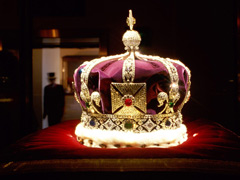


Now it’s a tourist site that attracts nearly 3 million people a year, but how much do you know about one of London’s most popular attractions?
The Tower of London was the brainchild of William the Conqueror, also known as the Duke of Normandy and the man who invaded England in 1066. The building was intended as a fortress, and at the grand height of 27 metres was the highest, most intimidating construction England had ever seen. Perhaps a little hard to believe now that its altitude pales in comparison to modern structures like The Shard and The Gherkin.
The oldest existing part of the building is the White Tower, which was started in 1076. It contains some of the Royal Armouries (including weapons and artillery dating back to pre-medieval times) and a chapel, which is thought to be the oldest in London.
Successive monarchs added extra towers and walls, all in the name of defence, but King John brought with him a rather more unusual addition: exotic animals. During his reign, which lasted from 1199 to 1216, he often lodged here, with his own private zoo for company. And why not? He was the King after all. The animals were usually given as gifts, but they also provided entertainment for the court. Bears, lions, elephants, rattlesnakes, ostriches, and other animals from faraway lands made up the Royal Menagerie; King John’s animal collection was in fact the basis for the London Zoo, which was established in the 1830s.
The exact number of people imprisoned at the Tower is unknown, but given its 900-year history of incarceration it’s bound to be a hefty figure. The river-facing entrance for prisoners is known as ‘Traitor’s Gate’, as treason was the most typical charge they faced. The Kray twins were among the last people to be held here in 1952 – their crime on this occasion? Not reporting for the army.
Depending on how severe the crime was, torture was sometimes employed. It was here that Guy Fawkes suffered the hideous fate of being hanged, drawn and quartered after his plot to kill King James and overthrow the monarchy failed. The Bloody Tower earned its unfortunate name thanks to Richard III, suspected of killing his two nephews, aged 12 and 10 in 1483. The motive for the killings is still not known. \n\nHenry VI was also executed here, as well as two wives of Henry VIII – it was something of an aristo prison if you will, where inmates were usually condemned for political or personal reasons. Lady Jane Grey was executed for treason by Mary I, because she had attempted to prevent her from accessing the throne. Nothing of the sort would happen these days (unless a parallel may be drawn here between a criminal allegation conveniently popping up to overshadow a case, or cause. Hypothetically speaking).
Henry VIII had a particularly violent tenure at the Tower. He tired of his second wife, Anne Boleyn, when she failed to give him a son; she was accused of being unfaithful and was duly executed. He also beheaded Thomas More, a former friend as well as his Chancellor, for refusing to accept him as the head of the Church. There were others, some of which were burnt at the stake.
The Tower underwent a huge restoration project in the 19th century, in a bid to revive its gothic appearance, which had become fashionable in the Victorian era. As the medieval look was making a comeback, many of the institutions that were housed here, such as the Royal Menagerie and the Office of Ordnance (responsible for storing arms) moved out, and the Tower started to make the transition to tourist site. By 1901 half a million visitors were turning up to be mesmerised at the building’s gruesome history. But even though tourists were pouring in, the Tower was still used as an execution dock. The last person to be killed here was Josef Jakobs in 1941, charged with being a spy.
\n\nNo castle history would be complete without a ghost tale or three. Anne Boleyn has supposedly been spotted wandering around the White Tower with her head neatly tucked under her arm. The fifth wife of Henry VIII, Catherine Howard (also accused of committing adultery) is said to scream on occasion throughout the Tower, as she made an attempt to flea but was caught and dragged back kicking and screaming before being executed. Then there was the sighting of a bear, which supposedly frightened one particularly jumpy guard so much that he dropped dead of shock.
Perhaps the least colourful purpose of the Tower was as a safehold for valuables. Jewels belonging to the reigning monarchs such as crowns, scepters, and whatever other opulent regalia they owned, have been stored here since 1660. A few brazen individuals have attempted to steal the Crown Jewels over the years – in 1815 a woman tried to snatch the crown when it was still possible to touch it through bars. She didn’t get away with it, but she did manage to cause substantial damage to the crown as well as have a magistrate declare her insane.
But despite the dark side of the Tower, coronations and lavish victory parties were also held here.
An ice rink is erected in the winter months, and pop concerts have been hosted in the summer, with a makeshift stage just a few metres away from where an execution would have taken place many moons ago. And who knows, perhaps the ghosts of the ostriches and bears roam around here too of an evening.


